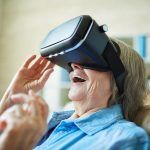Today in the United States, opioid addiction is a problem–a BIG problem. Big enough in fact that Health and Human Services (HHS) has declared it a national emergency, which is why natural pain relief solutions are getting more and more attention all the time.

Natural Chronic Pain Relief
VR uses computer technology to create a 3-dimensional world which feels real to the user—thus the term “virtual reality.” While this concept may be captivating to gamers and other online users, it is becoming even more so for researchers seeking new pain management medications. (2)

This goes along with the long-observed phenomena of emotions and expectations increasing the pain response. Simply put, this means that if you fear pain or expect something to hurt, your pain response will increase over what you may otherwise feel without these fears or expectations. (3)
Closing the Gate

This may take the form of relaxing imagery such as lazing on a warm tropical beach, swimming with dolphins, strolling through green forests or other warm, inviting, natural scenarios. The main idea is for these pleasurable imageries to help replace the pain response so that quality of life is restored. (4)
And, there is relevance to this theory, with recent studies showing that VR may reduce pain by up to 69% during sessions, and 53% immediately after. To put this in perspective, an opiate such as morphine reduces pain by only around 25-30%, meaning it is not only more dangerous, but a potentially less effective treatment as well. (5)
Making Headway in the Fight against Opiates
Due to the promising nature of VR as a tool in reducing chronic pain, more research and development is being done to create even more personalized and immersive experiences. This includes the use of data analytics to optimize pain-reduction, as well as completely new technologies such as combining the power of VR with complicit learning and other techniques to alter how pain is perceived.

The VR Solution

And that alone makes the virtual world well worth exploring.
References:
- https://www.hhs.gov/about/news/2017/10/26/hhs-acting-secretary-declares-public-health-emergency-address-national-opioid-crisis.html
- https://electronics.howstuffworks.com/gadgets/other-gadgets/virtual-reality.htm
- https://www.verywellmind.com/what-is-gate-control-theory-2795208
- https://www.npr.org/sections/health-shots/2019/08/19/751495463/got-pain-a-virtual-swim-with-dolphins-may-help-melt-it-away
- https://www.clinicalpainadvisor.com/home/conference-highlights/painweek-2017/virtual-reality-for-pain-management-a-weapon-against-the-opioid-epidemic/
- https://www.ama-assn.org/delivering-care/opioids/understanding-opioid-epidemic-s-economic-toll




